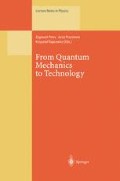Abstract
Dense hydrogen, a dual Fermion system, possesses a Hamiltonian of high symmetry and especial simplicity. As a consequence of the latter its ground state energy satisfies general scaling conditions, independent of phase. Electron exchange is an important contributor, and its role in proton pairing (so evident at low densities) can be argued as a persistent feature. In the single particle description instabilities associated with band-gap closure can be seen as incipient charge density waves but in pair coordinates. This gives rise to a notion of higher pairing within which there can be an associated broken symmetry in electron density (consistent with the observed infrared activity). The persistence of exchange driven pairing under conditions where temperatures approach characteristic vibron energies is discussed in the context of recent reports of the metallization of hydrogen by dynamic methods.
Preview
Unable to display preview. Download preview PDF.
References
W. Kohn and J. M. Luttinger, Phys. Rev. Lett 15, 524 (1965).
Y. Takada, Phys. Rev. B 47, 5202 (1993).
K. Moulopoulos and N.W. Ashcroft, Phys. Rev. B 41, 6500 (1990).
T. Kato, Commun. Pure Appl. Math 10, 151 (1957)
J.C. Kimball, Phys. Rev. 7, 1648 (1973).
A.E. Carlsson and N.W. Ashcroft, Phys. Rev. 25, 3474 (1982).
H. Kleinert, Fort. Phys. 26, 565 (1978)
V.N. Popov, in Functional Integrals and Collective Excitations (Cambridge University Press, Cambridge, 1987).
K. Moulopoulos and N.W. Ashcroft, Phys. Rev. Lett. 66, 2915 (1991).
S.T. Weir, A.C. Mitchell, and W. Nellis, Phys. Rev. Lett. 76, 1860 (1996).
See, for example, M. Hanfland, R.J. Hemley, and H.K. Mao, Phys. Rev. Lett. 70, 3760 (1993)
L. Cui, N. Chen, and I.F. Silvera, Phys. Rev. B 51, 14987 (1995).
W. Kolos, and L. Wolniewicz, J. Chem Phys. 49, 404 (1968).
W. Kolos, and C.J.J. Roothan, Rev. Mod. Phys. 32, 219 (1960).
J.C. Slater, in Quantum Theory of Molecules and Solids (McGraw Hill, New York, 1963).
C.O. Almbladh, U. von Barth, Z.D. Popovic, and M.J. Stott, Phys. Rev. B 14, 2250 (1976).
K. Moulopoulos and N.W. Ashcroft (to be published)
A.C. Maggs and N.W. Ashcroft, Phys. Rev. Lett. 59, 113 (1987).
C. Rapcewicz and N.W. Ashcroft, Phys. Rev. B 44, 4032 (1991).
A. Ferraz and N.H. March, J. Phys. Chem. Solids 45, 627 (1984).
M. Li, R. J. Hemley, and H. K. Mao, Bull. Am. Phys. Soc. 39, 336 (1994).
L. Pauling, Phys. Rev. 36, 430 (1930).
N. W. Ashcroft, Phys. Rev. Lett. 21, 1748 (1968).
K. Moulopoulos and N.W. Ashcroft, Phys. Rev. B 45, 1151B(1992).
W. Kohn, Phys. Rev. Lett. 133A, 171(1964).
B. Edwards and N.W. Ashcroft (to be published).
L. Onsager, J. Phys. Chem., 43, 189 (1939).
D.E. Ramaker, L. Kumar, and F.E. Harris, Phys. Rev. Lett. 34, 812 (1975).
C. Friedli and N.W. Ashcroft, Phys. Rev. B 16, 662 (1977).
T.W. Barbee, A. Garcia, M.L. Cohen, and J.L. Martins, Phys. Rev. Lett. 62, 1150 (1989).
H. Nagara and T. Nakamura, Phys. Rev. Lett. 68, 2915 (1991).
E. Kaxiras and Z. Guo, Phys. Rev. B 49, 11822 (1994).
E. Kaxiras, J. Broughton, and R.J. Hemley, Phys. Rev. Lett. 67, 1138 (1991).
H. Chacham and S.G. Louie, Phys. Rev. Lett. 66, 64 (1991).
N.F. Mott, Phil Mag 6, 287 (1961).
N. W. Ashcroft, “Elementary Processes in Dense Plasmas”; S. Ichimaru and S. Ogata, Eds. (Addison Wesley, 1995), p. 251.
B. Edwards and N.W. Ashcroft, Europhysics Letters, to appear (1996).
D. Saumon and G. Chabrier, Phys. Rev. A 44, 5122 (1991)
Phys. Rev. A 46, 2084 (1992).
B. Edwards and N.W. Ashcroft (to be published).
N.W. Ashcroft, Phys. Rev. B. 41, 10983 (1990).
D.J. Stevenson and N.W. Ashcroft, Phys. Rev. A 9, 782 (1974).
A. Louis and N.W. Ashcroft (to be published).
N.W. Ashcroft, Zeits. für Phys. Chemie. 156, 41 (1988).
N.W. Ashcroft, Physics World 8, 45 (1995).
Author information
Authors and Affiliations
Editor information
Rights and permissions
Copyright information
© 1996 Springer-Verlag
About this paper
Cite this paper
Ashcroft, N.W. (1996). Theory of dense hydrogen: Proton pairing. In: Petru, Z., Przystawa, J., Rapcewicz, K. (eds) From Quantum Mechanics to Technology. Lecture Notes in Physics, vol 477. Springer, Berlin, Heidelberg. https://doi.org/10.1007/BFb0106011
Download citation
DOI: https://doi.org/10.1007/BFb0106011
Published:
Publisher Name: Springer, Berlin, Heidelberg
Print ISBN: 978-3-540-61792-1
Online ISBN: 978-3-540-70724-0
eBook Packages: Springer Book Archive

